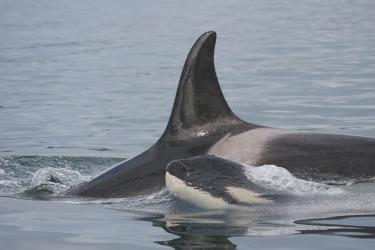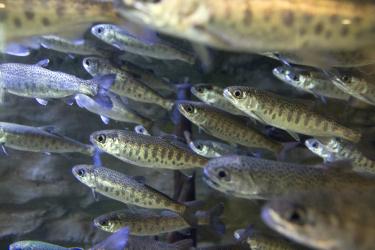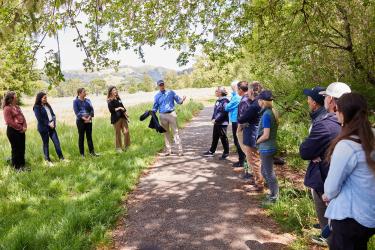In November 2021, we lost a visionary, an explorer, and an advocate of science-based approaches to fisheries management and aquaculture. Conrad Mahnken died this past November at the age of 84.
During his 34 year NOAA career, Conrad “Connie” Mahnken charted new territories for the restoration of Endangered Species Act listed salmon, the development of marine aquaculture, and the development of the NOAA’s Manchester Research Station.
“Connie was a visionary who foresaw the role aquaculture could play in sustainable fisheries and was an active and vocal advocate,” said Robert Iwamoto, Former Division Director and Director of Operations for NOAA’s Northwest Fisheries Science Center (NWFSC). “Connie’s long career was accented with many firsts, including the first pilot-scale net-pen farming of salmonids in Puget Sound, the first captive broodstocks of ESA-listed Atlantic and Pacific salmon for restoration, and among the first to recognize the need for hatchery reform and then developing the necessary guidelines.”
Mahnken had a talent for recognizing how research areas like genetics, behavioral ecology, and physiology could help better understand the ocean. Further, he had the power of persuasion and administrative creativity to turn ideas into action. He recognized talented scientists and invested in them and the infrastructure to support their science.
“I will always be grateful to Connie for supporting my Ph.D. research when I was discouraged by a significant setback,” said Penny Swanson, Director of the Environmental and Fisheries Science Division at NWFSC. “He changed my view of what was possible as a government scientist.”
“Connie Mahnken was the embodiment of what a mentor should be, advisor, leader, advocate, and collaborator, but most of all, friend,” said Michael Rust of NOAA’s Aquaculture Program.
Early Career
Before joining NOAA Fisheries, Mahnken received his bachelor's and master of science degrees in oceanography from the University of Washington. He spent his early postgraduate career as a biologist for the US Atomic Energy Commission and then as an oceanographer for the Department of Interior, Bureau of Commercial Fisheries. He joined NOAA when it was first formed within the Department of Commerce in 1970, and the Bureau of Commercial Fisheries was renamed the National Marine Fisheries Service.
His scientific endeavors at that point ranged from studying the fate of radioisotopes in the aquatic food web following atmospheric nuclear tests on Bikini Atoll to studies of tuna ecology in the tropical Atlantic and Caribbean. His at-sea research studies contributed to developing U.S. commercial fisheries by better understanding the distribution of commercially important tuna species and their seasonal migration in the tropical Atlantic.
In 1969, he made landmark contributions to the Apollo era of undersea exploration. He was one of four US aquanauts in NOAA’s Man in the Sea Program to occupy the Tektite Underwater Laboratory in the Great Lameshur Bay off the US Virgin Islands. He set a new world record for the number of days underwater (60 days on the seafloor).
Joining NOAA
Mahnken joined NOAA Fisheries in 1970. He was instrumental in founding the Northwest Fisheries Science Center’s Manchester Research Station on the western shores of Puget Sound.
He was a staunch advocate for science-based approaches to fisheries management and aquaculture. He saw the Research Station as a premier facility for NOAA Fisheries scientists to conduct laboratory studies of marine and anadromous fish and shellfish. He served as Program Manager and Director of the Manchester Research Station for 30 years.
“Connie had an incredible ability to bring all the right people together to tackle big and difficult science and management problems,” said Barry Berejikian, current Station Chief of the NOAA’s Manchester Research Station.
Under his leadership, research at the station focused on the conservation and recovery of threatened and endangered Pacific salmon and steelhead in the Pacific Northwest, science to improve the effectiveness of hatcheries, and the development of commercial marine aquaculture. During his tenure at the NWFSC, he received his Ph.D. from the School of Aquatic and Fisheries Sciences at the University of Washington, emphasizing the environmental impacts of marine aquaculture operations.
Lasting Legacy
Mahnken and his staff pioneered new conservation and enhancement strategies, including the development of captive broodstock technology as a tool for the recovery of endangered salmon. In addition, his team developed the passive integrated transponder (PIT) tags for monitoring the movement of salmon past hydroelectric projects.
The first genetics lab within NOAA Fisheries was established at the Manchester Research Station under Mahnken’s leadership, well before NMFS incorporated population genetics into fisheries management. He initiated a captive broodstock program for several stocks of Atlantic salmon from rivers in the northeastern USA using the net pens at the Manchester Research Station. During the early days of the development of net-pen aquaculture, he transferred technology that had been developed at Manchester to Norwegian scientists and maintained a strong collaboration with them for several years.
His international work on aquaculture expanded to Japan through the U.S.-Japan Cooperative Program on Natural Resources (UJNR) Aquaculture Panel, which he chaired. “Connie introduced me to Japan’s science and culture through his leadership of the UJNR Aquaculture Panel,” said Rust. “As the current UJNR chair, I am now the beneficiary of the path that Connie forged.”
Mahnken was a member of NOAA Fisheries Biological Review Teams for proposed ESA listings of Pacific Northwest salmon. He was the first NOAA Aquaculture Matrix and Program Manager. In addition, he served as a member of the Hatchery Scientific Review Group, a group of nine independent scientists guiding hatchery reform in Washington State. After his retirement in 2004, Dr. Mahnken served as a Commissioner on the Washington State Fish and Wildlife Commission until 2016.
Mahnken received the US Department of the Interior gold medal, the US Department of Commerce gold medal, and the US Navy Meritorious Service Award. He authored or co-authored more than 100 scientific publications.
“Serving under Connie at the Manchester Research Station, I learned to only see possibilities and what could be accomplished by teams of hard-working, passionate scientists,” notes Berejikian. “All of us who worked alongside him at the Station had the utmost respect for him as a person, leader, scientist and saw him as a major force in shaping the landscape of salmon and marine fish conservation and enhancement.”




